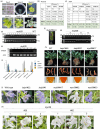Transgene-free CRISPR/Cas9-mediated gene editing through protoplast-to-plant regeneration enhances active compounds in Salvia miltiorrhiza
- PMID: 38174833
- PMCID: PMC11123421
- DOI: 10.1111/pbi.14285
Transgene-free CRISPR/Cas9-mediated gene editing through protoplast-to-plant regeneration enhances active compounds in Salvia miltiorrhiza
Keywords: CRISPR; protoplast regeneration; ribonucleoprotein.
Conflict of interest statement
The authors declare no conflict of interest.
Figures

References
-
- Deng, C. , Shi, M. , Fu, R. , Zhang, Y. , Wang, Q. , Zhou, Y. , Wang, Y. et al. (2020) ABA‐responsive transcription factor bZIP1 is involved in modulating biosynthesis of phenolic acids and tanshinones in Salvia miltiorrhiza . J. Exp. Bot. 71, 5948–5962. - PubMed
Publication types
MeSH terms
Grants and funding
- AS-KPQ-107-ITAR-107/Innovative Translational Agricultural Research Administrative Office, Academia Sinica
- AS-KPQ-108-ITAR-108/Innovative Translational Agricultural Research Administrative Office, Academia Sinica
- AS-KPQ-109-ITAR-109/Innovative Translational Agricultural Research Administrative Office, Academia Sinica
- 109-2313-B-001-011/Ministry of Science and Technology, Taiwan
- 105-2313-B-001-007-MY3/Ministry of Science and Technology, Taiwan
LinkOut - more resources
Full Text Sources

